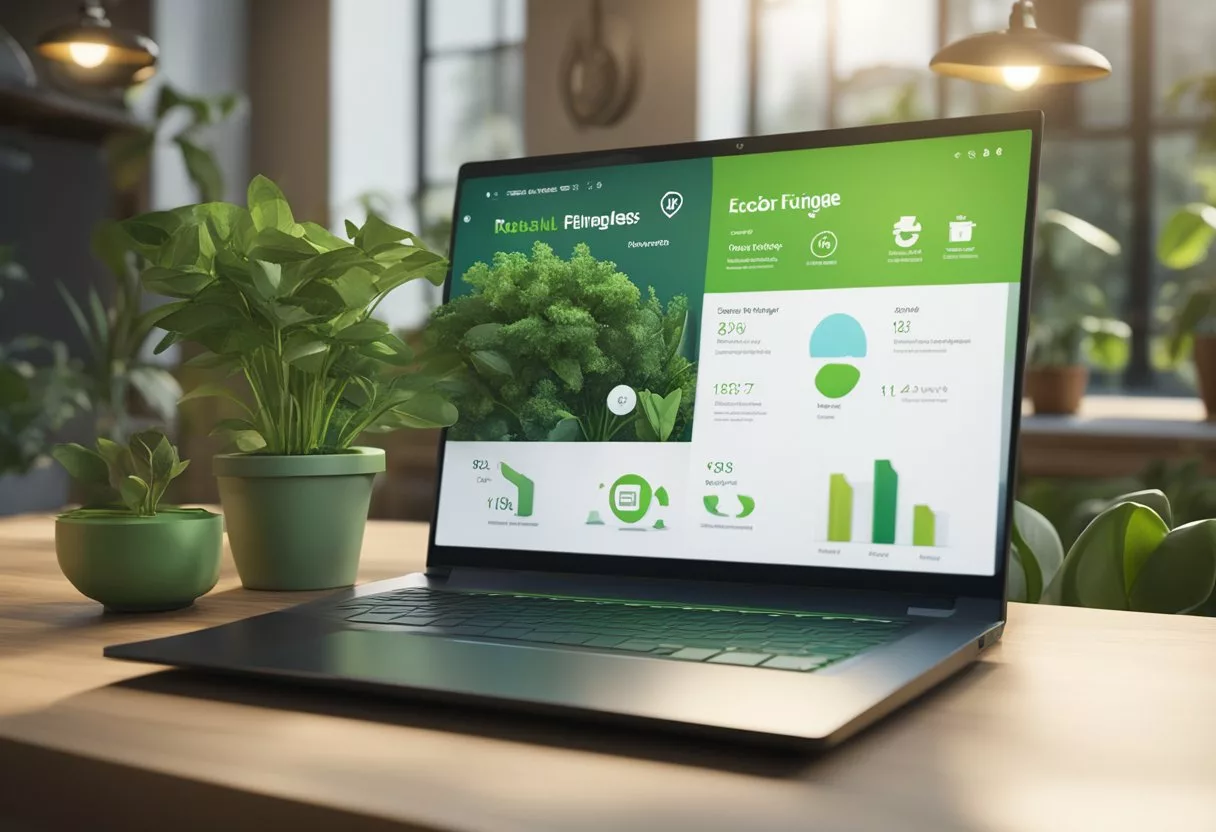Sustainable living is a lifestyle choice that prioritizes the health of the environment, society, and future generations. It involves adopting practices that reduce waste, conserve resources, and promote overall sustainability.
While it may seem daunting to make significant changes to one’s lifestyle, there are many simple and effective strategies that individuals can implement to live more sustainably.

Understanding sustainability is key to making lifestyle changes that promote it. It involves recognizing the interconnectedness of environmental, social, and economic systems and how our actions impact these systems.
By adopting a sustainable lifestyle, individuals can reduce their carbon footprint, conserve natural resources, and promote a healthier planet for future generations.
Key Takeaways
- Sustainable living involves adopting practices that prioritize the health of the environment, society, and future generations.
- Understanding sustainability and its interconnectedness is key to making lifestyle changes that promote it.
- By implementing simple and effective strategies, individuals can reduce their carbon footprint, conserve natural resources, and promote a healthier planet for future generations.
Understanding Sustainability

The Impact of Personal Choices on the Environment
Every individual’s actions have a significant impact on the environment. The choices people make daily, such as the type of food they eat, the mode of transportation they use, and the products they buy, contribute to their carbon footprint.
Carbon footprint is the amount of greenhouse gas emissions that an individual or organization produces. These emissions are responsible for climate change, which is a significant threat to the environment and human life.
Defining Sustainable Living
Sustainable living is a lifestyle that aims to reduce the impact of human activities on the environment. It involves the responsible use of natural resources to meet the needs of the present generation without compromising the ability of future generations to meet their own needs.
Sustainable living involves making conscious choices that minimize waste, reduce greenhouse gas emissions, and conserve natural resources.
Sustainable living can be achieved through various strategies such as reducing energy consumption, using renewable energy sources, reducing waste, conserving water, and adopting sustainable transportation methods.
By adopting sustainable living practices, individuals can contribute to reducing their carbon footprint and mitigating the effects of climate change.
Energy Conservation Strategies

There are various ways to conserve energy and reduce carbon dioxide emissions. This section highlights some of the most effective energy conservation strategies that can be easily implemented in daily life.
Reducing Home Energy Use
Reducing energy use at home is one of the most effective ways to save energy and reduce electricity bills.
One way to do this is by using natural light instead of artificial lighting. This can be achieved by using large windows or skylights to bring in more natural light.
Another way to reduce energy use is by using energy-efficient appliances such as Energy Star certified refrigerators, air conditioners, and washing machines.
These appliances use less energy and can significantly reduce electricity bills.
Installing a programmable thermostat can also help reduce energy use. These thermostats can automatically adjust the temperature based on a person’s routine, ensuring optimal heating or cooling only when needed.
Using one can save about 8% on heating and cooling expenses [1].
Investing in Renewable Energy
Investing in renewable energy is another way to conserve energy and reduce carbon dioxide emissions.
One of the most popular renewable energy sources is solar power. Installing solar panels on a home or business can significantly reduce energy bills and carbon dioxide emissions.
In addition, many governments offer incentives and tax credits for installing solar panels.
Energy-Efficient Appliances
Using energy-efficient appliances is another effective way to conserve energy and reduce carbon dioxide emissions.
Energy-efficient appliances such as refrigerators, air conditioners, and washing machines use less energy and can significantly reduce electricity bills.
In addition, using compact fluorescent light (CFL) bulbs instead of traditional incandescent bulbs can also help reduce energy use.
[1] Source: Top Ways to Conserve Energy: 25 Smart Strategies for Home and Planet
Waste Reduction and Management

Reducing waste and managing it responsibly is an essential part of a sustainable lifestyle. There are several ways to achieve this, including composting and organic waste management, recycling and upcycling, and minimizing single-use plastics.
Composting and Organic Waste
Composting is an excellent way to manage organic waste and reduce the amount of waste sent to landfills.
It involves collecting organic waste such as food scraps, yard waste, and leaves and allowing them to decompose naturally. The resulting compost is a nutrient-rich soil amendment that can be used to fertilize plants and gardens.
To start composting, one can use a compost bin or create a compost pile in their backyard. It is essential to balance the ratio of green and brown materials to ensure proper decomposition.
Green materials include food scraps, grass clippings, and coffee grounds, while brown materials include dry leaves, cardboard, and wood chips.
Recycling and Upcycling
Recycling involves converting waste materials into new products, while upcycling involves repurposing waste materials into something of higher value.
To recycle effectively, it is essential to sort materials into their respective categories, such as paper, plastic, and glass. Many communities have curbside recycling programs that make recycling easy and convenient.
Upcycling is a creative way to give new life to old items. For example, glass jars can be used as storage containers, and old t-shirts can be turned into cleaning rags.
Upcycling not only reduces waste but also saves money and adds a personal touch to one’s home.
Minimizing Single-Use Plastics
Single-use plastics are a significant contributor to pollution and waste. They include items such as plastic bags, water bottles, and straws.
To minimize their use, one can switch to reusable alternatives such as cloth bags, refillable water bottles, and metal straws.
Another way to reduce plastic waste is to choose products made from recycled materials. For example, recycled toilet paper reduces the demand for virgin materials and cuts down on the amount of waste sent to landfills.
Sustainable Food Choices

Eating sustainably is an essential part of a sustainable lifestyle. Making sustainable food choices can help reduce the environmental impact of food production, promote local food systems, and support regenerative farming practices.
Adopting a Plant-Based Diet
One of the most effective ways to reduce the environmental impact of food production is by adopting a plant-based diet.
Plant-based diets are rich in fruits, vegetables, legumes, and whole grains, and are low in processed foods, sugar, and refined grains. Plant-based diets have been shown to reduce the risk of chronic diseases such as heart disease, diabetes, and certain types of cancer.
Supporting Local and Sustainable Food Systems
Supporting local and sustainable food systems is another way to promote sustainable food choices.
Buying local produce and supporting local farmers helps reduce the carbon footprint of food transportation and supports the local economy.
Look for farmers’ markets, community-supported agriculture (CSA) programs, and local food co-ops to find fresh, locally grown produce.
Regenerative farming practices also play a crucial role in sustainable food systems. Regenerative farming focuses on building healthy soil, promoting biodiversity, and reducing the use of synthetic fertilizers and pesticides.
Supporting regenerative farming practices can help reduce the environmental impact of food production and promote healthy ecosystems.
Eco-Friendly Transportation

Transportation is one of the biggest contributors to greenhouse gas emissions. However, there are several eco-friendly transportation options that can help reduce carbon footprint and promote sustainability. In this section, we will discuss some of the best ways to travel sustainably.
Utilizing Public Transport and Cycling
One of the best ways to reduce carbon footprint is to utilize public transport.
Public transport options such as buses, trains, and trams are eco-friendly and can help reduce the number of vehicles on the road.
Cycling is another great option for shorter distances. It is healthy and eco-friendly. It also helps reduce traffic congestion and air pollution.
According to Sustainably Forward, “Opting for public transport and cycling can significantly reduce greenhouse gas emissions and traffic congestion while providing health benefits.” It is also a cost-effective option.
The Benefits of Walking and Carpooling
Walking is another great way to reduce carbon footprint. It is a healthy and eco-friendly option that does not require any fuel or resources.
Carpooling is another way to reduce the number of vehicles on the road and promote sustainability.
By sharing rides with friends or colleagues, it is possible to reduce carbon footprint and save money on fuel costs.
Sustainable Fashion and Personal Items

Choosing Slow Fashion Over Fast Fashion
Fast fashion has become a global phenomenon, but it comes at a cost to the environment. The fashion industry is one of the most polluting industries in the world. Fast fashion contributes to textile waste, water pollution, and the use of toxic chemicals.
Choosing slow fashion can significantly reduce your environmental impact. Slow fashion refers to clothing that is made to last, using high-quality materials and ethical production methods.
When shopping for clothes, consider investing in high-quality pieces that will last longer and can be worn in multiple ways. Opt for classic styles that will never go out of fashion, rather than trendy pieces that will quickly become outdated.
Additionally, buying second-hand clothing is an excellent way to reduce your carbon footprint and save money. Thrift stores, consignment shops, and online marketplaces like eBay and Poshmark are great places to find unique and affordable clothing.
Selecting Natural Materials and Eco-Friendly Products
When it comes to personal items such as reusable cotton pads, shampoo bars, and menstrual cups, selecting natural materials and eco-friendly products can help reduce your environmental impact.
Reusable cotton pads are a great alternative to disposable cotton pads, which contribute to landfill waste. Meanwhile, shampoo bars are an eco-friendly alternative to traditional bottled shampoo. They use less packaging and are often made with natural ingredients.
Menstrual cups are another sustainable option for menstrual care. They can be reused for up to 10 years and produce less waste than disposable tampons and pads.
Additionally, selecting products made from natural materials such as organic cotton and bamboo can also reduce your environmental impact.
Conserving Water and Protecting Aquatic Ecosystems

Water is a precious resource that is essential for life. Conserving water is a crucial part of a sustainable lifestyle. By reducing water usage, individuals can help protect aquatic ecosystems and ensure that future generations have access to clean water.
Water Conservation Methods
There are many ways to conserve water in daily life. One simple method is to turn off the tap while brushing teeth or shaving. This can save up to four gallons of water per minute.
Fixing leaky faucets and toilets can also save significant amounts of water. A single leaky faucet can waste up to 3,000 gallons of water per year.
Another way to conserve water is to use low-flow showerheads and faucets. These fixtures use less water without sacrificing water pressure.
Taking shorter showers and using a bucket to catch excess water can also help conserve water.
Water conservation extends beyond the home. Individuals can also conserve water by using drought-resistant plants in their gardens and landscaping. These plants require less water and are better suited to the local climate.
Additionally, using a broom instead of a hose to clean driveways and sidewalks can save significant amounts of water.
Implementing Water Catchment Systems
Water catchment systems are an excellent way to conserve water and protect aquatic ecosystems. These systems collect rainwater and store it for later use.
Rainwater can be used for irrigation, washing cars, and flushing toilets.
There are many types of water catchment systems available. Rain barrels are a simple and affordable option for homeowners. These barrels collect rainwater from gutters and downspouts and store it for later use.
More advanced systems, such as cisterns and underground tanks, can store larger amounts of water.
Building and Housing for a Sustainable Future

Eco-Friendly Home Construction and Renovation
The construction and renovation of homes can have a significant impact on the environment. Sustainable living is becoming more popular, and homeowners are increasingly looking for ways to build and renovate their homes in an eco-friendly manner.
The use of eco-friendly materials, such as recycled wood, bamboo, and cork, can reduce deforestation and promote biodiversity. Additionally, using insulation made from recycled materials can help reduce the amount of methane released into the atmosphere.
When renovating or constructing a home, it is also important to consider energy-efficient appliances, lighting, and heating and cooling systems. These can help reduce energy consumption and lower utility bills.
Homeowners can also consider installing solar panels to generate their own energy and reduce their reliance on non-renewable resources.
Landscaping with Native Plants
Landscaping can also have a significant impact on the environment.
Homeowners can promote biodiversity and reduce water usage by landscaping with native plants. Native plants are adapted to the local climate and require less water and maintenance than non-native plants. Additionally, they provide habitat for local wildlife and help reduce the amount of pesticides and fertilizers needed.
In addition to using native plants, homeowners can also consider installing rain barrels or other water collection systems to collect rainwater for use in landscaping. This can help reduce water usage and lower utility bills.
Promoting Sustainability in the Community

Sustainability is not just an individual effort, but also a collective one. Communities play a vital role in promoting sustainability. By working together, communities can create a more sustainable future for themselves and the planet. Here are some strategies that can be adopted to promote sustainability in the community.
Community Engagement and Education
Community engagement and education are essential for promoting sustainability.
Communities can organize events, workshops, and seminars to educate people about the importance of sustainability. These events can cover topics such as reducing waste, conserving energy, and preserving biodiversity.
One effective way of promoting sustainability in the community is by creating community gardens. Community gardens provide a space for people to come together and grow their own food. They also promote biodiversity and help to reduce the carbon footprint of the community.
Government Policies and Incentives
Government policies and incentives can also play a significant role in promoting sustainability in the community.
Governments can provide incentives for individuals and businesses to adopt sustainable practices. For example, they can offer tax breaks for businesses that use renewable energy sources or provide subsidies for people who install solar panels on their homes.
Governments can also implement policies that promote sustainability. For instance, they can ban single-use plastics or require businesses to reduce their waste output.
These policies can help to reduce the amount of waste generated by the community and promote sustainable practices.
Lifestyle Changes and Daily Practices

Incorporating Eco-Friendly Cleaning and Personal Care
One of the easiest ways to reduce one’s environmental impact is by using eco-friendly cleaning products.
These products are made from sustainable and renewable resources, reducing the reliance on toxic chemicals and minimizing pollution. They are also safe for one’s health, as they are free from harsh chemicals that can cause respiratory problems, allergies, and skin irritations.
In addition to using eco-friendly cleaning products, one can also adopt other sustainable cleaning practices.
For example, one can make their own cleaners using natural ingredients such as vinegar, baking soda, and lemon juice. This not only reduces waste but also saves money.
When it comes to personal care, one can also make eco-friendly choices.
For example, one can switch to cloth diapers instead of disposable ones, which can save money and reduce waste. Additionally, one can use cloth instead of paper towels and napkins, which can also save money and reduce waste.
Adopting Mindful Consumption and Shopping Habits
Another way to live a more sustainable lifestyle is by adopting mindful consumption and shopping habits.
This means being more conscious of what one buys and how it is produced. For example, one can choose to buy products that are made from sustainable materials, such as bamboo or recycled plastic.
One can also choose to buy products that are produced using sustainable practices, such as fair trade or organic farming.
This not only supports sustainable practices but also helps to reduce one’s environmental impact.
In addition to being mindful of what one buys, one can also be mindful of how much they consume.
This means reducing waste by using reusable bags, water bottles, and containers instead of disposable ones. It also means being more conscious of food waste and making an effort to reduce it.
The Role of Technology and Innovation

Technology and innovation play a crucial role in promoting sustainable living. Advancements in technology have led to the development of sustainable solutions that help reduce carbon emissions and promote energy efficiency.
Advancements in Clean Energy and Sustainable Tech
Clean energy and sustainable tech have emerged as key drivers of sustainable living.
The development of renewable energy sources such as solar, wind, and geothermal power has helped reduce reliance on fossil fuels and cut down carbon emissions. According to a report by the International Energy Agency, renewable energy sources are set to account for 80% of the world’s electricity generation by 2050.
In addition to renewable energy, there has been a surge in the development of sustainable tech solutions that help reduce energy consumption.
Smart home technology, for instance, allows homeowners to monitor and control their energy usage, resulting in reduced utility bills. The use of LED lighting and energy-efficient appliances has also helped reduce energy consumption.
Furthermore, the development of sustainable transportation solutions such as electric cars and public transport systems has helped reduce carbon emissions from the transportation sector.
This has also led to reduced air pollution, resulting in improved air quality in urban areas.
Engaging with Sustainability on Digital Platforms

In today’s world, social media has become an essential tool for raising awareness about environmental issues and promoting sustainable lifestyles.
By leveraging social media platforms, individuals and organizations can reach a wider audience and share their sustainability efforts with the world.
Leveraging Social Media for Environmental Awareness
Social media platforms such as Facebook, Instagram, and Twitter can be used to promote environmental awareness and encourage sustainable lifestyles.
By sharing informative content, individuals and organizations can educate their followers about the impact of their daily choices on the environment.
One effective way to leverage social media for environmental awareness is by creating visually appealing infographics.
Infographics can effectively communicate complex information in a concise and easy-to-understand format.
For example, an infographic showing the amount of plastic waste generated by a single person in a year can help raise awareness about the need to reduce plastic consumption.
Another way to leverage social media for environmental awareness is by partnering with influencers or other organizations.
By collaborating with like-minded individuals or organizations, individuals can amplify their message and reach a wider audience.
For example, a sustainable fashion brand can partner with a popular fashion influencer to promote sustainable fashion choices.
Frequently Asked Questions

How can individuals incorporate sustainability into daily routines?
Individuals can incorporate sustainability into their daily routines by making small changes in their lifestyle.
For example, they can reduce their energy consumption by turning off lights and unplugging appliances when not in use.
They can also reduce their water usage by taking shorter showers and fixing leaky faucets.
Additionally, they can reduce their waste by recycling, composting, and using reusable bags, containers, and water bottles.
What are practical examples of sustainable living practices?
Practical examples of sustainable living practices include using public transportation, biking, or walking instead of driving, buying locally grown and organic foods, and reducing meat consumption.
Other examples include using eco-friendly products, choosing energy-efficient appliances, and using natural cleaning products.
What sustainability strategies can students apply in their lives?
Students can apply sustainability strategies in their lives by reducing their energy and water consumption, using public transportation or carpooling, and supporting local and organic food producers.
They can also reduce their waste by recycling and composting, using reusable bags and containers, and avoiding single-use plastics.
How can we adopt sustainable habits within our homes?
To adopt sustainable habits within our homes, we can reduce our energy consumption by using energy-efficient appliances and turning off lights and electronics when not in use.
We can also reduce our water usage by fixing leaky faucets and using low-flow showerheads and toilets.
Additionally, we can reduce our waste by composting, recycling, and using reusable bags, containers, and water bottles.
What measures can be taken to promote sustainability in the workplace?
To promote sustainability in the workplace, measures can be taken such as using energy-efficient lighting, reducing energy consumption by turning off lights and electronics when not in use, and using natural lighting when possible.
Additionally, companies can encourage employees to carpool, use public transportation, or bike to work.
Companies can also reduce their waste by recycling and composting, using eco-friendly products, and reducing paper usage.
How can the principles of reduce, reuse, and recycle be implemented to enhance sustainability in everyday life?
The principles of reduce, reuse, and recycle can be implemented to enhance sustainability in everyday life. We can reduce our consumption of resources and reuse items instead of throwing them away. We can also recycle materials that can be reused.
For example, we can reduce our use of plastic bags by using reusable bags. We can also reuse glass jars and containers instead of throwing them away. Additionally, we can recycle paper, plastic, glass, and metal cans.